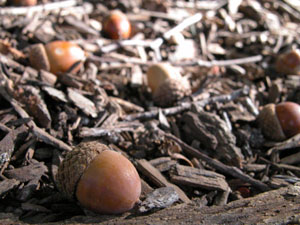By Nancy Allen
nallen@dailystandard.com State wildlife biologists are reporting an unusually large crop of acorns and other types of nuts this fall, which bodes well for the multitude of forest-dwelling wildlife that feeds on them.

Gary Steinbrunner, who runs a reforestation and wildlife services business, said he noticed the abundance of acorns while deer hunting last weekend with friends. He said he's never seen so many acorns.
"It sounded like rain there were so many acorns falling," Steinbrunner said this morning." When we were sitting around the campfire a couple of people got headaches," he said chuckling.
Acorns and other nuts are more abundant this year than anytime in recent memory, said Mike Reynolds, a forest wildlife biologist with the Ohio Department of Natural Resources Division of Forestry.
A large acorn crop leads to healthy wildlife populations because the nuts are high in energy and fat and provide a vital food source. Acorn production is cyclical with some trees producing acorns nearly every year while others rarely produce them, the release states. Based on the observation of selected oak trees in selected state wildlife areas, wildlife officials found that both white and red oak trees produced acorns throughout Ohio this year. The highest production was found in the southern half of the state.
An abundance of the mast crop, the term used for such food, presents a mixed bag for hunters. It can be good because they can expect to find deer, wild turkeys and squirrels feeding on acorns from chestnut oaks this fall.
But it also can be a hindrance for hunters because wildlife will be more spread out feeding on the large amount of food and less concentrated around farm fields.
Dan Balser, a forest health specialist with the Division of Forestry said there are many factors that contributed to the bumper crop of acorns this year, but the main ones include a large amount of rain in the spring, when oak trees do most of their growing and the lack of a major spring frost between April and May when oak trees flower. Flowering is necessary to produce acorns.
Balser said acorns are not consumed widely by humans today, but the Native Americans would boil the bitter-tasting tannin chemical out of the nuts and then grind them into flour. The Native Americans' main use for the nuts was to tan animal hides with, he said. |

